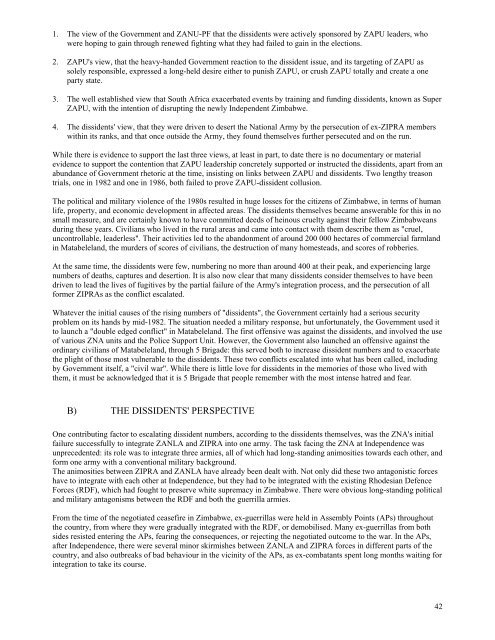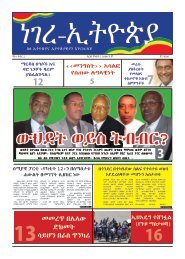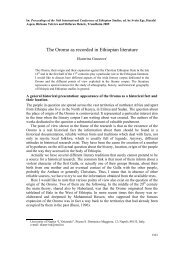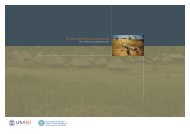MatabelelandReport
MatabelelandReport
MatabelelandReport
You also want an ePaper? Increase the reach of your titles
YUMPU automatically turns print PDFs into web optimized ePapers that Google loves.
1. The view of the Government and ZANU-PF that the dissidents were actively sponsored by ZAPU leaders, who<br />
were hoping to gain through renewed fighting what they had failed to gain in the elections.<br />
2. ZAPU's view, that the heavy-handed Government reaction to the dissident issue, and its targeting of ZAPU as<br />
solely responsible, expressed a long-held desire either to punish ZAPU, or crush ZAPU totally and create a one<br />
party state.<br />
3. The well established view that South Africa exacerbated events by training and funding dissidents, known as Super<br />
ZAPU, with the intention of disrupting the newly Independent Zimbabwe.<br />
4. The dissidents' view, that they were driven to desert the National Army by the persecution of ex-ZIPRA members<br />
within its ranks, and that once outside the Army, they found themselves further persecuted and on the run.<br />
While there is evidence to support the last three views, at least in part, to date there is no documentary or material<br />
evidence to support the contention that ZAPU leadership concretely supported or instructed the dissidents, apart from an<br />
abundance of Government rhetoric at the time, insisting on links between ZAPU and dissidents. Two lengthy treason<br />
trials, one in 1982 and one in 1986, both failed to prove ZAPU-dissident collusion.<br />
The political and military violence of the 1980s resulted in huge losses for the citizens of Zimbabwe, in terms of human<br />
life, property, and economic development in affected areas. The dissidents themselves became answerable for this in no<br />
small measure, and are certainly known to have committed deeds of heinous cruelty against their fellow Zimbabweans<br />
during these years. Civilians who lived in the rural areas and came into contact with them describe them as "cruel,<br />
uncontrollable, leaderless". Their activities led to the abandonment of around 200 000 hectares of commercial farmland<br />
in Matabeleland, the murders of scores of civilians, the destruction of many homesteads, and scores of robberies.<br />
At the same time, the dissidents were few, numbering no more than around 400 at their peak, and experiencing large<br />
numbers of deaths, captures and desertion. It is also now clear that many dissidents consider themselves to have been<br />
driven to lead the lives of fugitives by the partial failure of the Army's integration process, and the persecution of all<br />
former ZIPRAs as the conflict escalated.<br />
Whatever the initial causes of the rising numbers of "dissidents", the Government certainly had a serious security<br />
problem on its hands by mid-1982. The situation needed a military response, but unfortunately, the Government used it<br />
to launch a "double edged conflict" in Matabeleland. The first offensive was against the dissidents, and involved the use<br />
of various ZNA units and the Police Support Unit. However, the Government also launched an offensive against the<br />
ordinary civilians of Matabeleland, through 5 Brigade: this served both to increase dissident numbers and to exacerbate<br />
the plight of those most vulnerable to the dissidents. These two conflicts escalated into what has been called, including<br />
by Government itself, a "civil war". While there is little love for dissidents in the memories of those who lived with<br />
them, it must be acknowledged that it is 5 Brigade that people remember with the most intense hatred and fear.<br />
B) THE DISSIDENTS' PERSPECTIVE<br />
One contributing factor to escalating dissident numbers, according to the dissidents themselves, was the ZNA's initial<br />
failure successfully to integrate ZANLA and ZIPRA into one army. The task facing the ZNA at Independence was<br />
unprecedented: its role was to integrate three armies, all of which had long-standing animosities towards each other, and<br />
form one army with a conventional military background.<br />
The animosities between ZIPRA and ZANLA have already been dealt with. Not only did these two antagonistic forces<br />
have to integrate with each other at Independence, but they had to be integrated with the existing Rhodesian Defence<br />
Forces (RDF), which had fought to preserve white supremacy in Zimbabwe. There were obvious long-standing political<br />
and military antagonisms between the RDF and both the guerrilla armies.<br />
From the time of the negotiated ceasefire in Zimbabwe, ex-guerrillas were held in Assembly Points (APs) throughout<br />
the country, from where they were gradually integrated with the RDF, or demobilised. Many ex-guerrillas from both<br />
sides resisted entering the APs, fearing the consequences, or rejecting the negotiated outcome to the war. In the APs,<br />
after Independence, there were several minor skirmishes between ZANLA and ZIPRA forces in different parts of the<br />
country, and also outbreaks of bad behaviour in the vicinity of the APs, as ex-combatants spent long months waiting for<br />
integration to take its course.<br />
42







